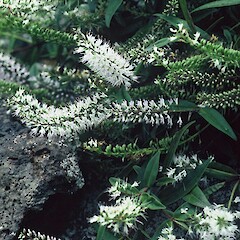Veronica bishopiana
Common name
Waitakere rock koromiko
Synonyms
Veronica xbishopiana Petrie, Hebe xbishopiana (Petrie) Hatch, Hebe bishopiana (Petrie) Hatch
Family
Plantaginaceae
Flora category
Vascular – Native
Endemic taxon
Yes
Endemic genus
No
Endemic family
No
Structural class
Trees & Shrubs - Dicotyledons
Chromosome number
2n = 40
Current conservation status
The conservation status of all known New Zealand vascular plant taxa at the rank of species and below were reassessed in 2017 using the New Zealand Threat Classification System (NZTCS) – more information about this can be found on the NZTCS website. This report includes a statistical summary and brief notes on changes since 2012 and replaces all previous NZTCS lists for vascular plants.
Please note, threat classifications are often suggested by authors when publications fall between NZTCS assessment periods – an interim threat classification status has not been assessed by the NZTCS panel.
- Conservation status of New Zealand indigenous vascular plants, 2017 . 2018. Peter J. de Lange, Jeremy R. Rolfe, John W. Barkla, Shannel P. Courtney, Paul D. Champion, Leon R. Perrie, Sarah M. Beadel, Kerry A. Ford, Ilse Breitwieser, Ines Schönberger, Rowan Hindmarsh-Walls, Peter B. Heenan and Kate Ladley. Department of Conservation. Source: NZTCS and licensed by DOC for reuse under the Creative Commons Attribution 4.0 International licence.
2017 | Threatened – Nationally Vulnerable | Qualifiers: RR, Sp
Previous conservation statuses
2012 | Threatened – Nationally Vulnerable | Qualifiers: RR, Sp
2009 | Threatened – Nationally Vulnerable | Qualifiers: RR, Sp
2004 | Threatened – Nationally Vulnerable
Brief description
Low growing shrub bearing pairs of dark green (reddish when young) glossy narrow leaves inhabiting rocky sites in the Waitakere area. Twigs red. Leaves 40-90mm long by 13-18mm wide, widest towards base, blunt-tipped. Leaf bud without gap at base. Flowers white tinged pink, in a spike to 17cm long.
Distribution
Endemic. North Island. Known only from the Waitakere Ranges, west of Auckland city, where it occurs from the upper Anawhata and Waitakere Stream south to Destruction Gully. This is the only vascular plant endemic to the Waitakere Ranges.
Habitat
Stream sides, gorges, damp or partially shaded rock outcrops, often in or around seepages on cliff faces, or protruding from Astelia banksii A.Cunn. clumps at the apex of rock outcrops.
Detailed description
Low spreading shrub up to 2 x 1 m (usually much less). Branches widely angled, spreading, often rooting at nodes. Old stems grey-black, branchlets maroon-black. Leaf bud without sinus, dark maroon in colour. Leaves lanceolate elliptic (20-)40-90 x (8-)13-18(-22) mm, maroon-green or dark-green, apex acute or acuminate. Inflorescences lateral, racemose 50-70(-110) mm long; flowers crowded. Calyx lobes ovate, subacute, overlapping at edges, 1.5-3 mm long. Corolla white tinged purple, tube 2-4 mm long, narrow, lobes suberect, ovate to lanceolate, acute 2-4 x 2-3 mm. Anthers purple, acute, 2.5 mm long, filaments purple, 6-8 mm long. Style purple, 6-8 mm long, ovary cylindrical, minutely puberulent. Capsule ovate, acute, dark maroon brown 3-4.5 x 2.5-4 mm, apex minutely puberulent.
Similar taxa
Sympatric with Veronica macrocarpa, V. stricta, and V. obtusata. From these species it can be distinguished by its low stature, maroon branchlets, dark-green, to maroon foliage, and often acuminate leaf apices. It is perhaps most similar to H. obtusata from which if differs by its much longer lanceolate, acuminate, dark-green to maroon tinged leaves, which lack hairy margins.
Flowering
March to August (sporadic flowering may occur throughout the year)
Flower colours
Violet/Purple, White
Fruiting
April to November
Life cycle
Seeds are wind dispersed (Thorsen et al., 2009).
Propagation technique
Very easily grown from fresh seed and semi hardwood cuttings. An excellent low shrub for a sunny place. Does best in a damp but free draining soil, though it is drought tolerant. A spectacular plant when planted on a rock wall. The maroon tinged dark green leaves are attractive on their own. However, this species has a long flowering period and is rarely without at least some flowers.
Threats
A very localised species common in only a few stream catchments and rock outcrops of the Waitakere Range. At most sites it is threatened by the spread of pampas grass (Cortaderia selloana) and Mexican daisy (Erigerion karvinskianus). It was, until recently severely threatened by mistflower (Ageratina riparia) but the successful introduction of biocontrols for that weed four years ago has all but eliminated it as a threat. One very large roadside population was virtually destroyed by the careless application of weed killer by a weeds contractor for a local authority.
Etymology
veronica: Named after Saint Veronica, who gave Jesus her veil to wipe his brow as he carried the cross through Jerusalem, perhaps because the common name of this plant is ‘speedwell’. The name Veronica is often believed to derive from the Latin vera ‘truth’ and iconica ‘image’, but it is actually derived from the Macedonian name Berenice which means ‘bearer of victory’.
bishopiana: Named after John J. Bishop (1865-1933), who collected the type specimen.
Notes on etymology
John J. Bishop grew this plant in his garden and collected it jointly with H. Carse and E. Jenkins (de Lange 1996a).
Attribution
Fact Sheet Prepared by P.J. de Lange (1 November 2004). Description based on de Lange (1996b) - see also Bayly & Kellow (2006).
References and further reading
Bayly M.; Kellow A. 2006: An Illustrated Guide to New Zealand Hebes.Te Papa Press: Wellington
de Lange, P.J. 1996a: A brief background to J.J. Bishop (1865-1933). Auckland Botanical Society Journal 51(2):63-65.
de Lange, P.J. 1996b: Hebe bishopiana (Scrophulariaceae) - an endemic species of the Waitakere Ranges, west Auckland, New Zealand. New Zealand Journal of Botany 34: 187-194.
Thorsen, M. J.; Dickinson, K. J. M.; Seddon, P. J. 2009. Seed dispersal systems in the New Zealand flora. Perspectives in Plant Ecology, Evolution and Systematics 11: 285-309
NZPCN Fact Sheet citation
Please cite as: de Lange, P.J. (Year at time of access): Veronica bishopiana Fact Sheet (content continuously updated). New Zealand Plant Conservation Network. https://www.nzpcn.org.nz/flora/species/veronica-bishopiana/ (Date website was queried)









